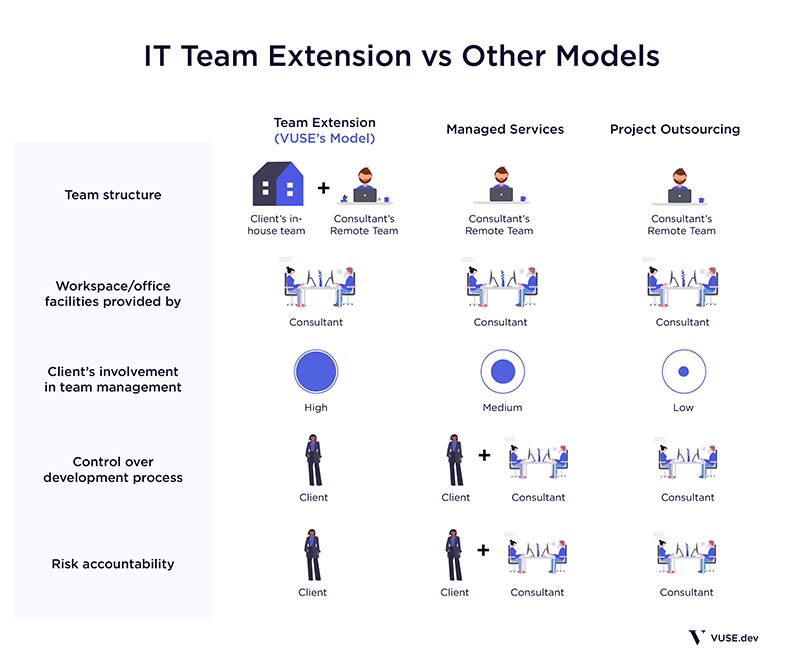Hiring an external dedicated team extension can help perform development tasks a company can’t (or don’t want to) do in-house for as long as they need them. It can contribute to the company’s short- and long-term goals without the hassle of hiring full-time employees that might not be needed after their project ends. A dedicated team:
• Is ready to get started with the company’s project
• Eases up tasks and time for the in-house staff
• Stays focused and more engaged with completing the project on-time
• Can quickly help build an MVP or demo
• Participates in helping the company expand to anew, unknown markets
• Supports the company’s project growth and overcome obstacles
• Provides a relief to the in-house team so they can work on other projects
A dedicated team extension (also knowns as team augmentation) helps startups become more established and scale quickly, as well as help mature businesses reach specific business goals.

The Dedicated Team Model
The dedicated team model is an extension of the in-house team, working together with the internal team as remote employees of the company.
A dedicated software development team can be comprised of front-and back-end engineers, quality assurance engineers, UX/UI designers, DevOps, business analyst, and project managers.
If the company’s project requires more developers or specialized team members for the project, the hiring is taken care by the consultant instead of the company in need. This puts all responsibility on the outsourced team leaders to interview, vet and hire new specialists or developers, and the administrative tasks of the team. This ensures the company controls the workflow, and can switch their attention to high-level tasks for the in-house team to concentrate on. The overall performance of the team and the individual’s KPIs are constantly evaluated for team efficiency by the team leads, since they all work within the same office. If an obstacle becomes present, the workflow can be quickly adjusted.
When selecting a cooperation model, examine the company’s needs and evaluate the risks involved. The dedicated team model works for four reasons:
• Quick project growth and expansion. A dedicated team extension lets the company form a ready-to-hire team by skipping the tedious recruitment and hiring processes. The consulting company hires and selects the team members needed for the project and places them in the same location to work as a team. This allows the internal team to continue focusing on more pressing company business-oriented tasks.
• Long-term projects with multiple tasks. This is a flexible team that can shift focus to overcome obstacles or setbacks within a project. A dedicated team model can easily adapt to any project, decrease risk opportunities, and lower the chance of failure to implement new ideas to the project while maintaining quality throughout the SDLC.
• Projects that need support for a fixed and considerable workflow. Maintaining an adequate workflow ensures the company continues to see results with the investment of the outsourced team. Otherwise, the company will be paying the outsourced team for day(s) there are no active tasks to complete. The latter is not cost-effective but ensures the dedicated team does not contract with another development company during the project timeline.
• Company expansion. A dedicated team model increases the overall workload and the onboarding processes as the company has time and focus for the in-house team to scale and support a larger consumer population. This also allows the dedicated team managers to support the company’s onboarding process by training new developers and provide the details of the project.

Dedicated Team Onboarding Processes and Management
Legal Aspects
The dedicated teams’ agency handles the legal aspects of hiring and maintaining developers, all within the US. Before the new members are hired by the client or begin working on a company project, a few legalities are needed to ensure company privacy and to avoid any tax issues. There are a few disclosures the hiring company will need to provide to the outsourced company during the onboarding process:
• A Non-Disclosure Agreement is a legal document for the client to guarantee the new hires will not share sensitive internal company information, including the project itself. This document states what information is considered confidential, ensuring the person can use the disclosed information for the project purposes-only, and what the penalty is.
• A Statement of Work specifies the scope of work, deliverables, schedule, acceptance criteria, duration, standards, and any other terms, conditions, or special requirements for the project and future related projects.
• The Master Services Agreement defines the cooperation with the outsourced company. This document specifies the terms of payment, disputes resolution, and intellectual property rights. This agreement needs to explicitly state who owns the copyright to all the work done if any part of the project has been outsourced. Otherwise, the outsourced company will have the rights to all or a portion of any projects developed.
"I've Picked the Team Members I Want, Now What?"
Once a dedicated team extension has been assigned to join a client’s staff and develop a software idea, a few questions may still arise. When is the development going to begin? What are the milestones, if any? How to introduce the teams to each other, in-house and outsourced? Will there be any tension between the teams?
The two teams may be working in two different time zones, but the dedicated team is still part of the company and needs to be treated as such. Explain the strategy and vision of the project, the goals of the company and the competitors, the company’s market and users, and strengths and weaknesses to the dedicated team. Learning the business context before working on the project’s development ensures the dedicated team will work smarter and maintain the company’s goal.
There may be tension between the company’s in-house team and the dedicated team. The in-house team may begin to feel superior leading to the dedicated team feeling left out. Before starting the development process, the company needs to talk to the in-house members who will be working with the dedicated team to ensure both teams are working towards the company’s goal of the project.
The extended team will have access to all the resources to start on the project’s development. The most important tools that the extended team will need to have are the backlogs, technical documentation, and code repositories. The company will need to provide all supporting documentation and access to the dedicated team, however, ensure the dedicated team is not overwhelmed with a plethora of information. If certain information or documentation is needed at a later date, then provide the support at the appropriate time.
Managing a team that operates remotely is not as hard or tricky as it may appear to be. The current pandemic has shown that productivity can still remain as high as ever when working remotely. The first step is to show trust towards the dedicated team. This will ensure the dedicated team members are valued and represented as any other internal employee. There are other steps to help manage an extended team alongside with the onboarding processes.
Organize Scheduled Meetings
Gather the remote team for a video or call conference on a regular basis. During this call, the dedicated team will need to know all the company project details. While many questions will stem about the project itself, a few other questions will need to be answered about the hierarchy of the project for communication and troubleshooting inquires, any current or standing obstacles, and the short-term plans or milestones for the project.
Holding daily or weekly meetings is a good practice for keeping all members, in-house and extended, updated, allowing employees to structure information on what has been done, and planning for future tasks. These meetings will need to be moderated and short. If a member starts to deviate from the plan, gives too much detailed information, or needs help, talk to the individual privately after the meeting for better overall communication.
Leverage Tools
Fortunately, there are tons of tools to help you keep track of your remote team. Here are some popular ones:
• All-in-one solutions. Troop Messenger, BasicOps, Hibox, Paymo, Hive
• Managing tasks: Trello, Jira, Twoodo, Wrike, Worksection, Avaza, Taskworld, TeamGantt,
• Document collaboration tools: Google Drive, Bit.ai
• Team communication tools: Skype, Zoom, Slack, SocialChorus, UberConference
Provide Constant Feedback
An essential aspect of managing a dedicated team is being responsive to the members. Software engineers may propose dozens of questions of various size to be answered within a time frame for the project to meet the company’s expectations. The feedback on the project guides the dedicated team to continue developing the project or cause it to come to a halt. Prompt feedback is essential for the extended team to complete the project’s milestones and ensure the project will be completed by the specified deadline. This can either increase or decrease the speed of the project and the pace of the dedicated team.
Dedicated Teams are Experienced Professionals
The members of a dedicated team are still software developer professionals holding specialized certifications similar (or better) to the company’s in-house team. Both teams need to be equals on the project as they are talented software developers working on the project. Ensure both teams’ expertise and opinions are considered and praise the teams for the work accomplished.
Dedicated Team Processes at VUSE
This is how dedicated teams at VUSE ease the setup process:
• Gathering requirements. This usually entails a project description, team size, and the desired workflow. This ensures VUSE can assemble the right team of professionals for the project.
• Assembling the team. VUSE will select unoccupied developers that are in-between projects for an client's interview and potential immediate hire. if VUSE does not have the required professionals available (unusual), VUSE will start a recruiting process that can take up to 2-3 weeks. The hiring team at VUSE consistently interviews and hires certified developers that are ready to join a client's team whenever the need arises.
• Talent selection. By assessing the candidates background, technical skills, English-proficiency level, and soft skills ensures a fit for the specific project. These developers will be the candidates the company can schedule interviews with and potentially hire immediately. At VUSE, the team ensures each developer is certified for the highest quality possible. If the candidate is not certified in a specialized skill, VUSE will pay for the candidate’s certificate before joining the company’s team.
• Integration. Upon hiring the right professionals, VUSE will ensure all candidates are informed on the ongoing project. The client is free to choose the preferred management approach and the tools the new hire will need to work on the project. A client might require to host daily and weekly video meetings with the outsourced and in-house teams to guarantee project milestones and details are being completed on-time and without delays.
• Results. Hiring a dedicated team with the help and support from VUSE ensures the company will receive quality professionals and results just like the company’s in-house team would. The dedicated team works remotely, and the software outsourcing manager will complete the administrative tasks.
Final Thoughts
Working with a dedicated software development team is a great way to augment an internal project and enhance the expertise a company may lack to ensure the project’s success. By hiring a dedicated team for a project that has flexible requirements and no time frame, it is guaranteed that the client will get the best results for their business. Hiring a dedicated team extension is a cost-effective alternative to hiring in-house US developers that provides a flexible team that can adapt to the company’s culture and is committed to their goals.
Have questions about hiring a dedicated team for your project? Contact the team at VUSE to learn more about how they can help you achieve your goals and help you throughout the whole hiring process.


